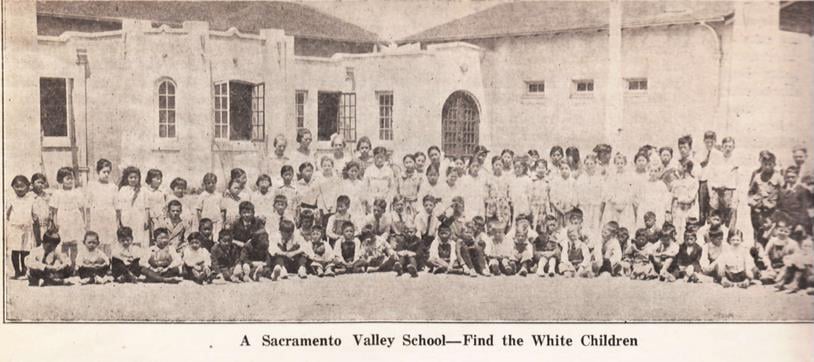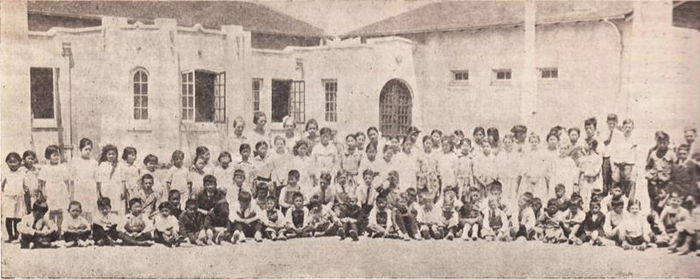Asian-American History, California History, Napa, People
Racism, Internment, and Assimilation: Being Japanese American in California
by Kate Todd, NCHS intern
TW for racist language.
Japanese immigration to California increased rapidly during the Meiji Restoration (1868-1912). Prior to the Restoration, Japan was closed to outside trade and most specifically Western influences. Japan was also suffering economically after the Russo-Japanese War (1904-1905) and as a result, many Japanese sought new opportunities and relief from poverty.[1] Japanese laborers were initially recruited to work on sugar plantations in Hawaii, mining endeavors in New Caledonia, and highway projects in the Philippines, as well as by American railroads, agriculture, and mining.[2]
The April 1920 issue of the Napa County Farm Bureau Monthly provided local insight into what California called its “Japanese Problem.”[3] California Senator J. M. Inman claimed the Japanese intended to “reproduce rapidly and take control of California farmland.”[4] Inman also believed Japan was intent on conquering the United States and referenced a Japanese law that required all Nisei to serve in the Japanese army in the event of war no matter where they resided to push his ideas. The idea that Nisei could fight in a war waged on behalf of the Japanese against the United States or a European nation strongly implied that Japanese immigrants and their American-born children were secret traitors would also later be used as a reason to move Japanese Americans into internment camps two decades later.[5]
In an article published in the 1921 Annals of the American Academy, John Irish, a wealthy landowner in the Sacramento and San Joaquin valleys and principal owner and editor of the Oakland Times, argued that California agribusiness and politics were approaching the Japanese in the same manner it had treated the Chinese just two decades earlier. Irish contended that it was the “Expulsion of the Chinese for their vices that created a labor vacuum that drew in the Japanese.”
The Japanese in California were caught between a rock and a hard place. An article written by a Japanese publicist in the Japan Advertiser illustrated this similarity by stating, “Americans do not want as their cohabitants a people whose color and physical traits that are essentially different from their own, nor do they want the Negro as such.”[6] The April 1920 Napa Farm Bureau Monthly addressed the issue of non-assimilation from the Japanese perspective through an article on Mr. Kowasiki. He argued that the Alien Land Law of 1913 had prevented Japanese farmers from purchasing or leasing land longer than three years and as a result, the Law had created intransigence among the Japanese.[7] He spoke of the frustration and alienation the Japanese felt under the constraints of the anti-Asian legislation saying, “It is your laws which make him [the Japanese] live this way. You do not try to lift him up.”[8]
Despite this hostile environment, many Japanese immigrants were also successful farmers and business people. California benefited from their achievements in agriculture with the cultivation of vineyards and orchards that were often grown many in regions previously thought to be un-farmable.[9] Historian Masakazu Iwata states that the Japanese were no different than any other immigrant in their desires to create a better life economically and the willingness to do so by working the most menial of jobs.[10]

In the 17 years following the Immigration Act of 1924, Japanese Americans and Japanese immigrants were once again subjected to legalized racism, especially through Executive Order 9066 issued by President Franklin Delano Roosevelt on February 19, 1942, that authorized all individuals of Japanese descent to be moved to relocation centers away from states that bordered on the Pacific. Napa County residents of Japanese descent were not immune to this relocation order.
In the NCHS research library is a collection of correspondence and ephemera compiled by Paul Fullert, a Japanese American and former Napa resident, during internment. Paul and his family lived in East Napa prior to relocation to Camp Amache in Granada, Colorado. Fullert was that he was in his late thirties at the time and worked as a sextant and handyman; he later became a photographer. The Fullert family consisted of Paul Fullert, his mother Maria (formerly Matsu), sisters Mary and Frieda, and brothers Joseph and Charley. Their father, Bernard, was a German Catholic but he passed away soon after the family’s immigration to Napa.
Paul attempted to have his family excused from the relocation effort on the basis that he and his siblings were of mixed race. However, in August 1942 the War Civilian Control Administration (W.C.C.A.) in San Francisco denied Paul’s request: “There is no provision in the mixed marriage policy justifying release of the Fullert family, and in view of their lack of citizenship and past Japanese environment, it has been determined that their application at this time must be denied.” Yuriko Domoto, the woman who typed the letter on behalf of the Chief of Regulatory Section of the W. C. C. A. Office in San Francisco added “We are sorry for this decision.” Under the cloud of war in Europe and Japan, Paul’s request for his family’s exemption undoubtedly made the Fullerts unlikely candidates for removal from the internment camp given their German and Japanese heritage and childhood in Tokyo.
Also in the collection are pamphlets from the War Relocation Authority that described the segregation process of people of Japanese ancestry and the relocation effort as “the separation of those who wish to follow the American way of life, and those whose interests are not in harmony with those of the United States.”[11] In reality nearly all Japanese Americans and Japanese immigrants were segregated regardless of patriotism. A newspaper clipping in the Fullert collection from the August 1945 Wyoming Republican & Boomerang addressed the difficulty in “Getting Nisei to leave the relocation centers” by arguing that the majority of internment residents were loyal and desperately needed for the United States’ war effort.[12] The author stressed that the intermingling of pro-Japanese with American loyalists had the potential of swaying the loyalists into being anti-American. Paul likely knew all correspondence was monitored by camp officials and he wisely expressed no incendiary opinions on the camps or his internment.

Paul was also a devout Catholic. There are multitudes of letters from his priest Father Zimmerman and news from various parishes as well as mentions of Paul’s faith in his correspondence with friends. The collection also contains several well-worn religious talismans adorned with St. Simon Stock and Our Lady of Mt. Carmel inscribed with “Pray for us.” Paul also made a small donation to Father Flanagan’s Boy’s Home in Nebraska.
A letter to Paul in June 1942 from Raymond A. Shaver indicated that the Shaver family were moving into the Fullert home in Napa during their internment. Shaver promised to take care of the home and to follow any special gardening requests. The tone of the letter implies that the Fullert home was left in good hands with the intention of returning it upon Paul’s release. In fact, Paul did return to Napa after the end of WWII. City directories show him residing in his family home in East Napa. Tragically, Joe Fullert never made it out of the internment camp. He died there in June 1944.
Fullert’s correspondence provides compelling insight into the day-to-day life for Japanese Americans inside the internment camps.
[1] Masakazu Iwata, “The Japanese Immigrants in California Agriculture,” Agricultural History 36, no. 1 (Jan, 1963): 26, http://www.jsotr.org/stable/3740395.
[2] Jules Becker, “The Course of Exclusion, 1882-1924: San Francisco Newspaper Coverage of the Chinese and Japanese in the United States,” PhD diss., University of California, Berkeley, 1986, http://0-search.proquest.com.iii.sonoma.edu/docview/303451253?accountid=13949.
[3] “Jap or White – Which?” Napa Farm Bureau Monthly (April 1920), The Arthur Schmidt Collection, Napa County Historical Society, 1996.31.3, pg. 1.
[4] Ibid., 3.
[5] “Another Round with the Jap,” Napa Farm Bureau Monthly, (May 1920), Arthur Schmidt Collection, Napa County Historical Society, 1996.31.3, pg. 3.
[6] A Japanese Publicist, “The American – Japanese Conflict,” The Living Age 321, no. 4171 (June 14, 1924): 1127. http://0-iii.sonoma.edu/docview/90246041?accountid=13949.
[7] “Jap or White,” 3.
[8] Ibid.
[9] Carey McWilliams, Factories in the Field: The Story of Migratory Farm Labor in California (Berkeley: University of California Press, 1966), 111.
[10] Iwata, “The Japanese Immigrants,” 25.
[11] U.S. War Relocation Authority, Segregation of Persons of Japanese Ancestry in Relocation Centers, Washington D.C. (August 1943). From the Fullert Collection. Napa County Historical Society, 2015.1.
[12] “Getting Nisei to Leave Centers is One of WRA’s Toughest Jobs,” Laramie Republican & Boomerang (August 11, 1943), pg. 1. From the Fullert Collection. Napa County Historical Society, SC 2015.1.


